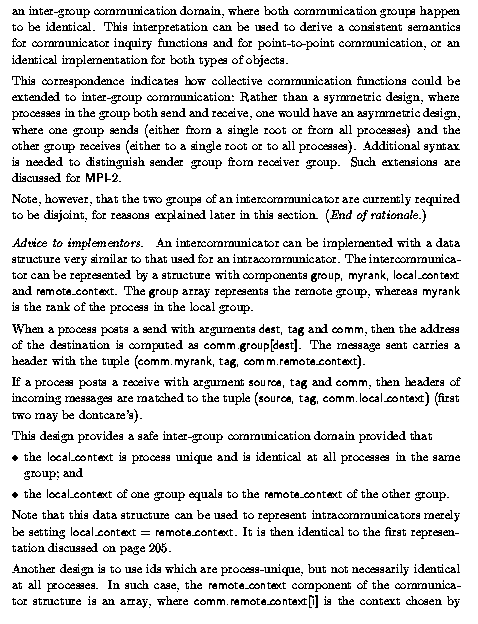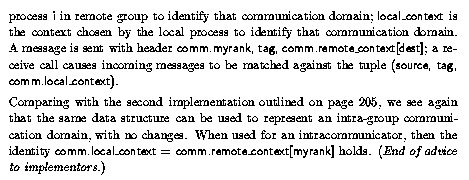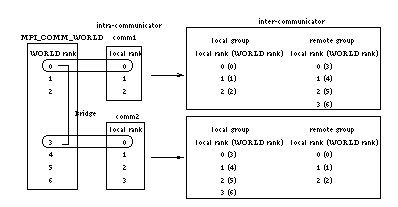This section introduces the concept of inter-communication and describes the portions of MPI that support it.
All point-to-point communication described thus far has involved communication between processes that are members of the same group. In modular and multi-disciplinary applications, different process groups execute distinct modules and processes within different modules communicate with one another in a pipeline or a more general module graph. In these applications, the most natural way for a process to specify a peer process is by the rank of the peer process within the peer group. In applications that contain internal user-level servers, each server may be a process group that provides services to one or more clients, and each client may be a process group that uses the services of one or more servers. It is again most natural to specify the peer process by rank within the peer group in these applications.
An inter-group communication domain is specified by a set of intercommunicators with the pair of disjoint groups (A,B) as their attribute, such that communication domain, inter
This distributed data structure is
illustrated
in Figure ![]() , for the case of a pair of groups
(A,B), with two (upper box) and three (lower box)
processes, respectively.
, for the case of a pair of groups
(A,B), with two (upper box) and three (lower box)
processes, respectively.

Figure: Distributed data structure for inter-communication domain.
The communicator structure distinguishes between a local group, namely the group containing the process where the structure reside, and a remote group, namely the other group. process group, local and remotegroup, local and remote The structure is symmetric: for processes in group A, then A is the local group and B is the remote group, whereas for processes in group B, then B is the local group and A is the remote group.
An inter-group communication will involve a process in one group
executing a send call and another process, in the other group, executing a
matching receive call.
As in
intra-group communication, the matching process (destination of send
or source of receive) is specified using
a (communicator, rank) pair. Unlike intra-group communication,
the rank is relative to the second, remote group.
Thus, in the communication domain illustrated in
Figure ![]() , process 1 in group A sends a message to
process 2 in group B with a call MPI_SEND(..., 2, tag, comm);
process 2 in group B receives this message with a call
MPI_RECV(..., 1, tag, comm).
Conversely, process 2 in group B sends a message to process 1 in group
A with a call to MPI_SEND(..., 1, tag, comm), and the message
is received by a call to MPI_RECV(..., 2, tag, comm); a
remote process is identified in the same way for the purposes of
sending or
receiving.
All point-to-point communication functions can be used with
intercommunicators for inter-group communication.
, process 1 in group A sends a message to
process 2 in group B with a call MPI_SEND(..., 2, tag, comm);
process 2 in group B receives this message with a call
MPI_RECV(..., 1, tag, comm).
Conversely, process 2 in group B sends a message to process 1 in group
A with a call to MPI_SEND(..., 1, tag, comm), and the message
is received by a call to MPI_RECV(..., 2, tag, comm); a
remote process is identified in the same way for the purposes of
sending or
receiving.
All point-to-point communication functions can be used with
intercommunicators for inter-group communication.
Here is a summary of the properties of inter-group communication and intercommunicators: intercommunication, summary
o The syntax of point-to-point communication is the same for both inter-and intra-communication. The same communicator can be used for send and for receive operations. o A target process is addressed by its rank in the remote group, both for sends and for receives. o Communications using and intercommunicator are guranteed not to conflict with any communications that use a different communicator. o An intercommunicator cannot be used for collective communication. o A communicator will provide either intra-or inter-communication, never both.The routine MPI_COMM_TEST_INTER may be used to determine if a communicator is an inter- or intracommunicator. Intercommunicators can be used as arguments to some of the other communicator access routines. Intercommunicators cannot be used as input to some of the constructor routines for intracommunicators (for instance, MPI_COMM_CREATE).



It is often convenient to generate an inter-group communication domain by
joining together two intra-group communication domains, i.e., building the pair
of communicating groups from the individual groups.
This requires that there exists
one process in each group that can communicate with each other
through a communication domain that serves as a bridge between the two groups.
For example, suppose that comm1 has 3 processes and
comm2 has 4 processes (see Figure ![]() ).
In terms of the
MPI_COMM_WORLD, the processes in comm1 are 0, 1 and 2 and
in comm2
are 3, 4, 5 and 6. Let local process 0 in each intracommunicator form
the bridge. They can communicate via MPI_COMM_WORLD where process 0
in comm1 has rank 0 and process 0 in comm2
has rank 3. Once the
intercommunicator is formed, the original group for each
intracommunicator is the local group in the intercommunicator and the
group from the other intracommunicator becomes the remote group. For
communication with this intercommunicator, the rank in the remote group is
used. For example, if a process in comm1 wants
to send to process 2 of
comm2 (MPI_COMM_WORLD rank 5) then it uses 2 as the rank in the
send.
).
In terms of the
MPI_COMM_WORLD, the processes in comm1 are 0, 1 and 2 and
in comm2
are 3, 4, 5 and 6. Let local process 0 in each intracommunicator form
the bridge. They can communicate via MPI_COMM_WORLD where process 0
in comm1 has rank 0 and process 0 in comm2
has rank 3. Once the
intercommunicator is formed, the original group for each
intracommunicator is the local group in the intercommunicator and the
group from the other intracommunicator becomes the remote group. For
communication with this intercommunicator, the rank in the remote group is
used. For example, if a process in comm1 wants
to send to process 2 of
comm2 (MPI_COMM_WORLD rank 5) then it uses 2 as the rank in the
send.

Figure: Example of two intracommunicators merging to become one
intercommunicator.
Intercommunicators are created in this fashion by the call MPI_INTERCOMM_CREATE. The two joined groups are required to be disjoint. The converse function of building an intracommunicator from an intercommunicator is provided by the call MPI_INTERCOMM_MERGE. This call generates a communication domain with a group which is the union of the two groups of the inter-group communication domain. Both calls are blocking. Both will generally require collective communication within each of the involved groups, as well as communication across the groups.

